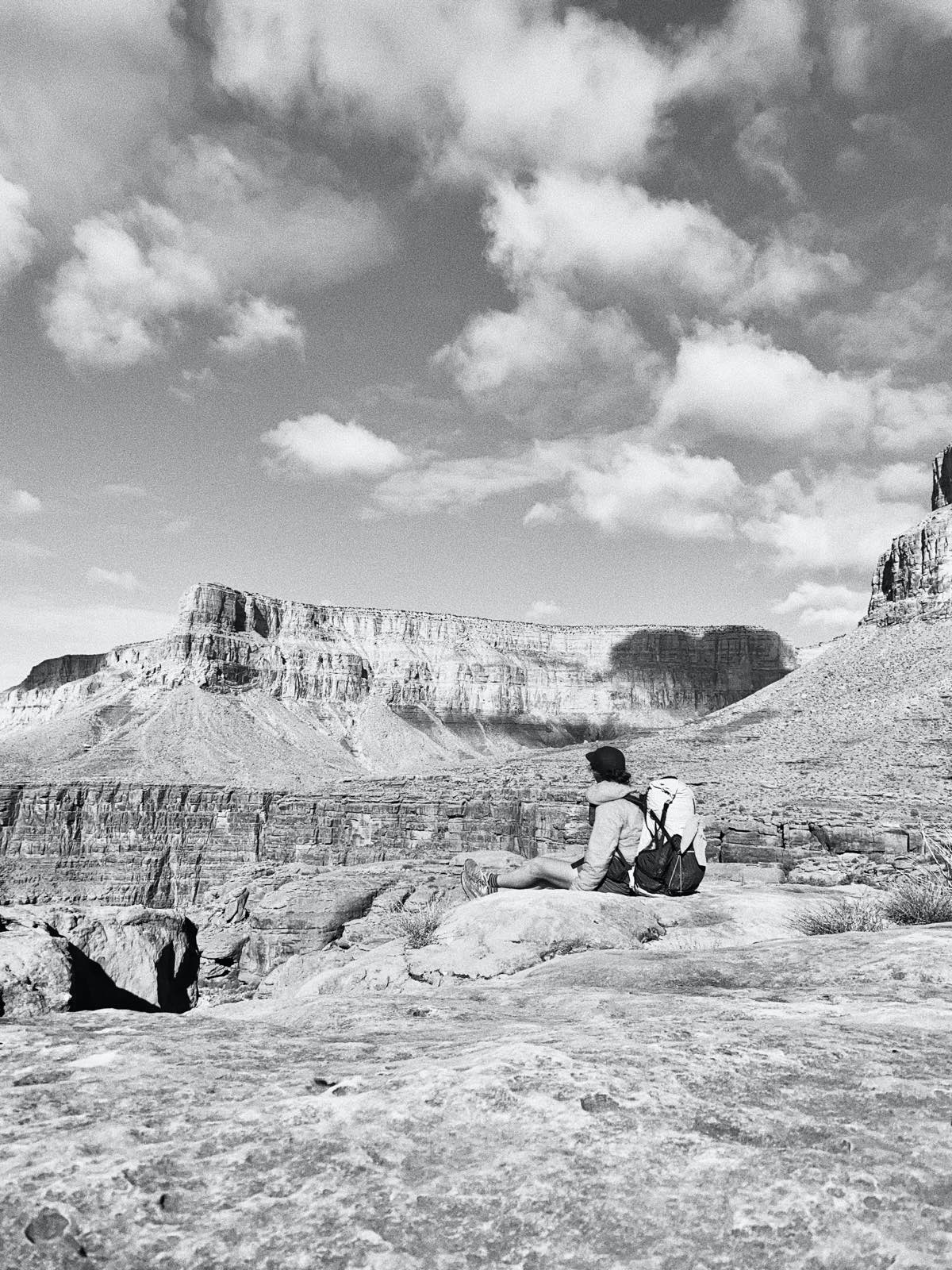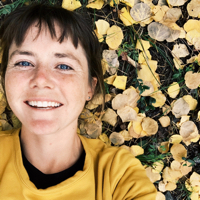I stare at the flint that scatters the ground all around my tent. I am in a remote section of the Grand Canyon in Arizona and after battling the wind all day, the perfect overhanging rock appears at sunset. The flint, which has been worked by someone’s hands likely in the process of making ancient tools, is evidence that others have previously sought shelter in this same spot.
I wonder: Who stayed here before and made tools from this rock? How many hundreds or thousands of years ago? And how many people have come in between?
The next day, I spot something in another nook. As I walk the sandstone lip around to the mouth of the cave, I realize it is remnants of an old cowboy camp: horseshoes, a bag of flour, a tub of lard, cans of baking soda, wood-handled spoons, an axe, and a roll of bedding. I scan the walls of the cave, as sometimes cowboys signed and dated their names. Suddenly something catches my eye. They aren’t cowboy glyphs, but red marks on the walls and a couple of notable spirals—a signature of Ancestral Puebloan pictographs. Thousands of years of human history exist in this one small cave.
. . .
In the Sangre de Christo Mountains of Colorado last fall, I was running a ridgeline and came across a rock with a perfectly circular bowl carved into it. While perhaps water could have carved it, it looked more human made, such as that of an ancient metate for processing grain and seeds. My mind wandered, But way up here, on a ridge at 12,000 feet altitude? What were they doing up so high?
I started thinking of the times my path has intercepted, what has sometimes felt serendipitously, the routes of ancient vagabonds. And maybe vagabond isn’t the right word to use here, because its dictionary definition is “a person who wanders from place to place without a home or job.” I think outside, whether in a tent or moving from one sheltered rock nook to another, can be a home too. A home need not be stationary. And serendipitous probably isn’t the right word, either. I think there is always a natural path through any landscape which humans and animals alike, follow.
One day last summer I was running a ridgeline high in Colorado’s San Juan Mountains. Very near the start, I spotted a bighorn sheep up ahead. I followed him over each summit. I lost sight of him at one point but followed his tracks through the most technical portion of the ridge and as I crested the final high point, there he was. For a moment I felt this deep connection to an animal species that has roamed these lands far before I existed. And I quickly reminded myself that humans, too, are animals.
. . .
I run out to the edge of the cliff, the clouds awash in the brilliant orange hues of sunset. I halt, staring thousands of feet down to the Colorado River. I fill my lungs up with air and yell as loud as I can into the dark chasm. A pause. Then a faint echo. I am alone out here, for at least as far as my voice can carry.
Back in my tent beneath the overhang I gaze out at the stars in the quiet, cold night. My thoughts wander to those who have slept here before me, the Grand Canyon and stars much the same as they were centuries ago. I often wonder what I am doing in the middle of nowhere. But I am neither the first, nor will I be the last to seek the solitude of this wild place.
Everett Reuss, the young, elusive vagabond who went missing in southern Utah’s canyon country in the 1930s, said it eloquently in A Vagabond for Beauty by W.L. Rusho:
“I have been fighting my way up tall hill hills, between canyons of skyscrapers, hurling myself against the battling night winds, the raw, swooping gusts that are like cold steel on my cheeks. I am drunk with a searing intoxication that liquor could never bring—drunk with the fiery elixir of beauty, the destroying draught of power, and the soul-piercing inevitability of music. Often I am tortured to think that what I so deeply feel must always remain, for the most, unshared, uncommunicated. Yet, at least I have felt, have heard and seen and known, beauty that is inconceivable, that no words and no creative medium are able to convey. Knowing that the cards are stacked, and realized achievements are mere shadows of the dream, I still try to give some faint but tangible suggestion of what has burned without destroying me.
“But I realize that what I have felt must grow within one, and it is folly that will be scorned and misinterpreted to seek to tell of it.
“Such is my cry, such is my plaint, and I know there is no reply. Mine seems a task essentially futile. Try as I may, I have never yet, that I know of, succeeded in conveying more than a glimpse of my visions. I am condemned to feel the withering fire of beauty pouring into me. I am condemned to the need of putting this fire outside myself and spreading it somewhere, somehow, and I am torn by the knowledge that what I have felt cannot be given to another. I cannot bear to contain these rending flames, and I am helpless to let them out. So I wonder how I can go on living and being casual as one must.”
Call for Comments
- When in your outdoor explorations have you crossed paths with those who came before you?
- Do you have thoughts on the notion of the vagabond, and also the idea that a home can be mobile or in the outdoors?

